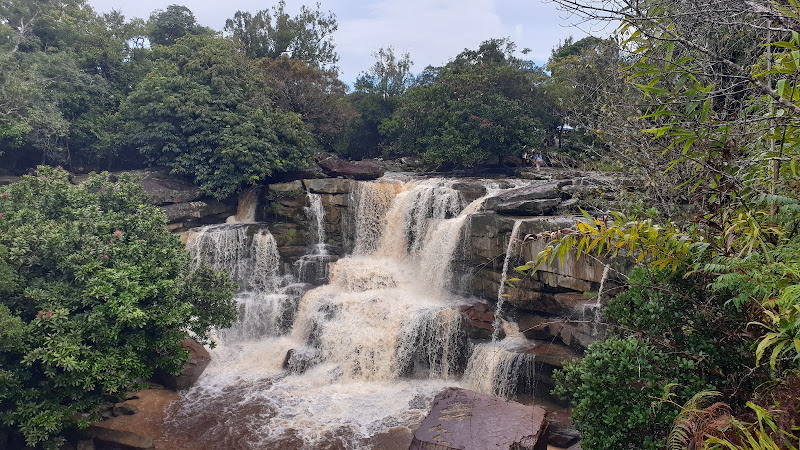About Popokvil Waterfall
Description
Located in the misty heights of Bokor National Park, Popokvil Waterfall tumbles down rocky outcrops creating a natural spectacle that's worth the journey up the mountain. [This waterfall attracts sizeable crowds](https://www.tripadvisor.com/Attraction_Review-g608455-d3633839-Reviews-Popokvil_Waterfall-Kampot_Kampot_Province.html) but manages to maintain its charm through multiple viewing areas. The falls consist of two main tiers, each offering its own unique perspective and photo opportunities. The sound of rushing water mingles with the cool mountain air, creating a refreshing escape from Cambodia's usual heat.
Key Features
• Two-tiered waterfall system with multiple viewing platforms
• Natural swimming pools (during wet season)
• Surrounding jungle trails for light hiking
• On-site restaurant serving local Khmer dishes
• Covered picnic areas for families
• Clean restroom facilities
• Ample parking space
• Well-maintained walkways to viewing points
• Natural rock formations perfect for photography
• Cool mountain climate compared to lowland areas
Best Time to Visit
Timing your visit to Popokvil Waterfall requires some strategic planning. The waterfall shows two completely different faces depending on when you go. During the rainy season (May to October), you'll witness the falls in their full glory, with water thundering down the rocks and creating impressive spray patterns. [However, during the dry season, water levels can be significantly lower](https://www.tripadvisor.in/ShowUserReviews-g608455-d3633839-r188007698-Popokvil_Waterfall-Kampot_Kampot_Province.html), sometimes barely a trickle. I'd recommend visiting early morning (around 8-9 AM) to avoid the afternoon crowds and catch the best lighting for photos. The cooler morning temperatures also make the walk to the viewing platforms more enjoyable.
How to Get There
Getting to Popokvil Waterfall is part of the adventure. The waterfall sits atop Bokor Mountain, and you'll need to navigate the winding mountain road to reach it. From Kampot town, you can rent a motorbike (make sure it's powerful enough for mountain roads), hire a tuk-tuk, or join a guided tour. The drive takes about an hour, but trust me - the scenery along the way is worth it. The road is well-paved but full of curves, so if you're driving yourself, take it slow and enjoy the views. Just keep following the main road up Bokor Mountain and watch for the clearly marked signs to the waterfall.
Tips for Visiting
Let me share some insider tips I've picked up from my visits. Bring cash for the entrance fee - they don't accept cards. Pack a light jacket or sweater because the mountain air can get surprisingly chilly, especially if you get wet. Wearing proper walking shoes is a must - those rocks can get slippery! If you're planning to swim (during wet season), bring a change of clothes and a towel.
Remember to pack some snacks and water, even though there's a restaurant on-site. The prices are a bit steep up there, and sometimes it gets pretty busy. Oh, and don't forget your camera - the lighting is usually best in the morning or late afternoon when the sun isn't directly overhead.
If you're visiting during rainy season, pack a raincoat instead of an umbrella - the mountain winds can make umbrellas useless. And speaking of weather, always check the forecast before heading up. The mountain can get really foggy, which might affect your view of the falls.
Keep your eyes peeled for local wildlife - the surrounding forest is home to some interesting birds and butterflies. But please, don't feed any animals you might encounter. And yeah, I learned this the hard way - bring insect repellent! The mosquitoes up there can be pretty enthusiastic about foreign visitors.
One last thing - the altitude might affect some people, so take it easy on the walks and stay hydrated. The combination of the mountain air and hiking can be more tiring than you'd expect. But honestly? The sight of the waterfall makes every bit of effort worthwhile.
Remember to respect the environment and other visitors. Take your trash with you, stick to marked paths, and you'll help preserve this beautiful spot for future travelers. The locals take pride in maintaining this natural wonder, and it's up to us visitors to help keep it that way.
Copyright © 2025 RealJourneyTravels.com. All Rights Reserved.


